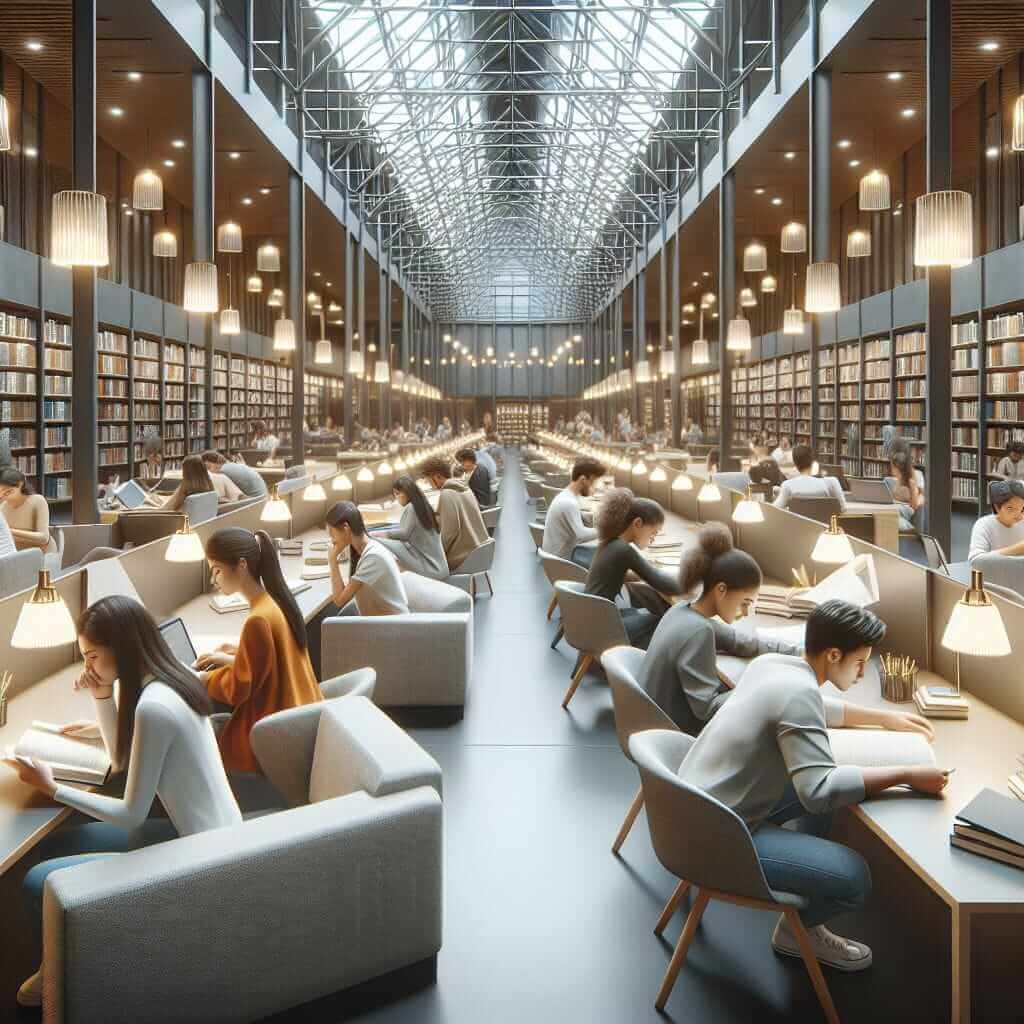The Speaking Test of the IELTS exam is designed to assess your speaking abilities in English and consists of three parts: Introduction and Interview, Long Turn, and Two-way Discussion. To excel in this part, candidates need to demonstrate fluency, coherence, lexical resource, grammatical range, and pronunciation. This test often includes questions that require candidates to describe a place or a familiar environment, such as a place where they like to study.
Part 1: Introduction and Interview
In Part 1, the examiner will ask general questions about you and a range of familiar topics, such as home, family, work, studies, and interests.
Common Questions:
- Can you describe a place where you like to study?
- What type of environment do you find best for studying?
- How often do you study in this place?
Sample Answer for Question 1:
“I usually like to study at my local library. It is a quiet place with plenty of resources such as books, journals, and computer access. The ambiance is very conducive for concentration, and I often find that I am able to absorb information better here than at home.”
Analysis:
In this answer, key elements such as the location (“library”), features (“quiet”, “resources”), and personal preference (“better concentration”) are highlighted. These elements demonstrate a clear and structured response, enhancing coherence and cohesion.
Part 2: Long Turn
Cue Card: Describe a place where you like to study
You should say:
- Where it is
- What it looks like
- Why you like studying there
- How often you go there
Sample Answer:
“One of my favorite places to study is the main library in my city. It is a modern building with large windows and plenty of natural light, which creates a serene and productive atmosphere. The library is equipped with state-of-the-art facilities including individual study cubicles, group discussion rooms, and a vast collection of reference materials.

I particularly enjoy studying here because of the quiet environment and the availability of resources that aid my research work. Moreover, the library often hosts study workshops and academic seminars, which provide additional learning opportunities. I try to visit this library at least three times a week, especially during exam periods.”
Analysis:
This answer uses descriptive language (“modern building”, “state-of-the-art facilities”) and specific examples (“study workshops”, “academic seminars”) to create a vivid image of the place. It also explains the reasons for preference and frequency of visits, supporting the main idea comprehensively.
Follow-up Questions:
-
What other places do you sometimes study at?
- “Sometimes, I study at local cafes, especially when I need a change of scenery. The slightly bustling environment can be surprisingly beneficial for brainstorming creative ideas.”
-
How important is it to have a dedicated study space?
- “Having a dedicated study space is crucial as it minimizes distractions and mentally prepares you to be productive. It creates a routine, which can significantly enhance one’s ability to focus and retain information.”
Part 3: Two-way Discussion
In Part 3, the examiner will ask more abstract questions related to the topic in Part 2.
Examiner: How do you think the design of a library can affect students’ studying habits?
Candidate:
“The design of a library can significantly influence students’ studying habits. A well-designed library with ergonomic furniture, good lighting, and adequate ventilation can make study sessions more comfortable and sustainable. Areas for individual study, as well as group collaboration, can cater to diverse learning needs, promoting both focused study and peer discussion.”
Analysis:
The candidate uses complex sentences and a range of vocabulary (“ergonomic furniture”, “adequate ventilation”) to express detailed insights. This reflects a higher level of lexical resource and grammatical control.
Examiner: Do you think technology has changed the way students study?
Candidate:
“Absolutely, technology has transformed the way students study by making learning more accessible and interactive. With digital libraries, online courses, and study apps, students can access information from anywhere and at any time. Additionally, tools such as e-books and educational software can enhance understanding and retention of subject matter.”
Analysis:
This response shows an ability to discuss abstract concepts using appropriate vocabulary and structures (“transformed”, “accessible and interactive”, “enhance understanding”). It also illustrates the candidate’s ability to develop an argument logically.
Vocabulary and Key Phrases
High-scoring Vocabulary
-
Conducive (adj): providing the right conditions for something to happen or exist
- Example: “The library offers a conducive environment for study.”
-
Ambiance (n): the character and atmosphere of a place
- Example: “The cozy ambiance of the cafe makes it a pleasant place to study.”
-
State-of-the-art (adj): very modern and using the most recent ideas and methods
- Example: “The library has state-of-the-art facilities.”
-
Vast collection (phrase): a large number of items grouped together
- Example: “The library boasts a vast collection of academic resources.”
Useful Phrases
-
Minimal distractions: Conditions that reduce interference with study
- Example: “The study room ensures minimal distractions.”
-
Mentally prepares: Getting oneself in the right mindset
- Example: “Having a dedicated study space mentally prepares me to be productive.”
Conclusion
To perform well in the IELTS Speaking Test, it is crucial to practice structured and detailed responses to common prompts. By incorporating high-level vocabulary and coherent structures, candidates can enhance their performance significantly. Continuous practice, along with familiarizing oneself with common topics and examiner expectations, can pave the way towards achieving a high band score.
For more detailed tips on handling IELTS Speaking questions, visit articles like Describe a person who is very reliable in their work or Describe a time when you had to manage multiple tasks.